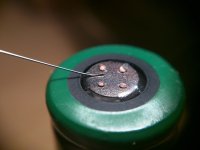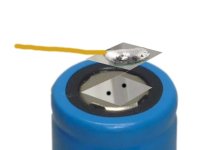I was curious about the same thing. The commonly-used pure nickel ribbon is 7mm wide and 0.15mm thick. That makes the cross section 7mm X
0.15mm = 1.05mm squared. Pure nickel has a conductivity of 22/100 compared to copper, so 1/4 at best?
https://www.bluesea.com/resources/108/Electrical_Conductivity_of_Materials
This means a 1.05mm squared nickel wire would be equal to a copper wire with a cross-section of about 0.27mm squared? That is equal to round cross-section copper wire of___
23.5-ga?
http://www.engineeringtoolbox.com/awg-wire-gauge-d_731.html
7mm X
0.20mm = 1.4mm sq. So, 1/4 is 0.35mm sq copper,
equal to...22-ga round cross-section copper wire
Nickel has a much higher melting temp of 2650F (1450C)...and copper is 1980F (1080C), 25% less? I imagine this is one of the reasons nickel is often used...it can get very hot without melting, but...it also causes a LOT of voltage sag due to resistance. You are converting battery watts into a lot of heat if you are using nickel.
The series-bars can be very fat copper (look at pics of E-motorcycle batteries, they regularly draw 200A+), but the parallel connection only has to normally provide 30% of the individual cells max capability (10A max cell = 30A melting fuse wire?).
If you are using high-amp cells in a very small pack, it would be tricky to get the fuse-wire "just right", but...I think if you have a fairly large battery pack with average-current cells (in order to access higher capacities), its easy to find a diameter of copper wire that will work. As an example, an affordable 3400-mAh GA cell seems to be comfortable at 6A each, and warm at 10A. maybe have the fuse wire melt at 30A to minimize resistance during normal operations? If the pack is a large 7P (14S / 24-Ah), then the full 7P amps would be an unrestricted 70A at a minimum, and likely more.
By comparison, on a tiny 2P pack using a high-amp 25R cell, a fuse-wire on each cell would need to flow 20A in normal operation without getting hot, and for an acceptable level of resistance, maybe 30A before it gets warm? That is close to the 40A the tiny 2P pack would put out. Without the BMS to restrict the amps during a short, a 2P 25R string would put out higher amps than 40A, but...to have a fuse-wire that is only warm at 30A, it might need to melt at 40A-50A.
Either way...if you were an electrical engineer that was hired to design a circuit and you specified pure nickel wire, you'd probably be fired. Tesla uses nickel-plated copper, nickel for corrosion resistance, and 95%+ copper core for conductivity. They use ultrasonic vibration friction-welding instead of spot-welding or soldering. Fuse-wire is easy for them to size for low resistance because they have an enormous parallel groups (high parallel amps) and only draw small amps from each cell.
[I am still learning, so...there's a good chance I've gotten something wrong here. Don't make any big decisions without doing your own research]





